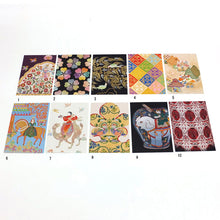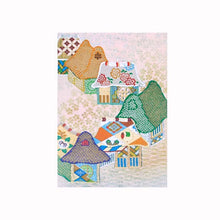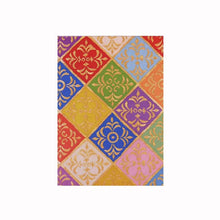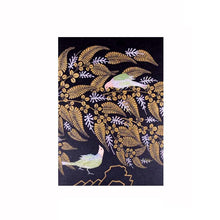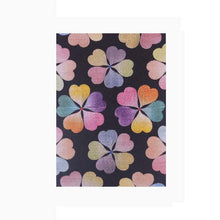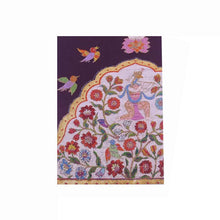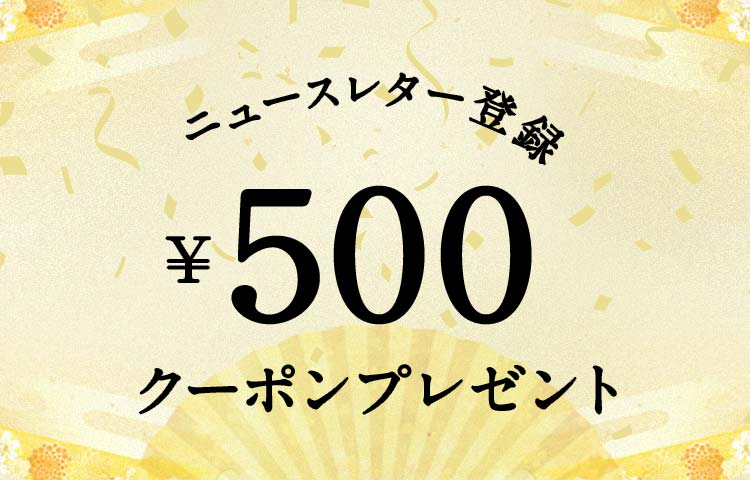
Detail
| Product : | Picture Postcard(B set 10pieces) |
|---|---|
| Type : | ステーショナリー |
| Size (cm) : | W10.5×H14.8 |
| Tags : | postcard、 Small Set、 Picture Postcards、 |
| Other : |
Reviews
Description
Original sketch designs of TATSUMURA fabric were printed onto the picture postcard.
Patterns
A total of 10 patterns.
1 Gold chintz with joyful design: Krishna, the god of India, is a master flute player. A scene of flowers blooming and birds dancing to the beautiful sound. The gorgeous atmosphere of gold chintz is expressed on the brocade.
2Nagetsuzakura: The cherry blossoms in mother-of-pearl inlay on the red bowl of the Kamakura Meigetsuan are a modern form. We interweaved its taste on Nishiki.
3Daisha Maki-e design: "Akinoshika Maki-e Tebako", a national treasure of Izumo Taisha Shrine. The scene of Akino is lyrically expressed by gold maki-e and mother-of-pearl inlay on black lacquer. The design is woven with creativity.
This is a design of the ground paper of the 36th poetry anthology. The splendidly dyed colored threads express the beauty of the dynasty.
5Hana no sato: Around the Genroku era. A view of a farmhouse in Kyoto in spring. The costumes show the elegance of the Koetsu School and the joyfulness of life.
6Danish Dolls: Scandinavian Denmark devotes itself to embroidery during the long winter. People are waiting for the end of winter and spring. It represents the world of fairy tales, where the queen plays in the flower garden on horseback.
7 Camel Ride: A five-stringed biwa that originated in India and remains in the Shosoin Repository. The figure of a hu-man riding a camel and playing a biwa. Raden (mother-of-pearl) adds color and exoticism to this piece.
8Mandarin Ducks and Ducks in Arabesque: The day of Todaiji Temple's foundation festival. This is the decoration of the edge of the banner hanging on the pillar. The design of a pair of mandarin ducks and a mandarin lion on a lotus represents the poetic sentiment of love between husband and wife.
9:White Elephant with Ceramic Decoration: A white elephant and a lady in a splendid Indian costume. This is a work of art by Heizo IV that expresses the swelling and three-dimensionality of the jar.
10Giyaman Nishiki: The shimmer of cut glass was sought in Satsuma Kiriko of the late Edo period. It is an attempt by Heizo IV to express the color and transparency of the glowing giyaman.
1 Gold chintz with joyful design: Krishna, the god of India, is a master flute player. A scene of flowers blooming and birds dancing to the beautiful sound. The gorgeous atmosphere of gold chintz is expressed on the brocade.
2Nagetsuzakura: The cherry blossoms in mother-of-pearl inlay on the red bowl of the Kamakura Meigetsuan are a modern form. We interweaved its taste on Nishiki.
3Daisha Maki-e design: "Akinoshika Maki-e Tebako", a national treasure of Izumo Taisha Shrine. The scene of Akino is lyrically expressed by gold maki-e and mother-of-pearl inlay on black lacquer. The design is woven with creativity.
This is a design of the ground paper of the 36th poetry anthology. The splendidly dyed colored threads express the beauty of the dynasty.
5Hana no sato: Around the Genroku era. A view of a farmhouse in Kyoto in spring. The costumes show the elegance of the Koetsu School and the joyfulness of life.
6Danish Dolls: Scandinavian Denmark devotes itself to embroidery during the long winter. People are waiting for the end of winter and spring. It represents the world of fairy tales, where the queen plays in the flower garden on horseback.
7 Camel Ride: A five-stringed biwa that originated in India and remains in the Shosoin Repository. The figure of a hu-man riding a camel and playing a biwa. Raden (mother-of-pearl) adds color and exoticism to this piece.
8Mandarin Ducks and Ducks in Arabesque: The day of Todaiji Temple's foundation festival. This is the decoration of the edge of the banner hanging on the pillar. The design of a pair of mandarin ducks and a mandarin lion on a lotus represents the poetic sentiment of love between husband and wife.
9:White Elephant with Ceramic Decoration: A white elephant and a lady in a splendid Indian costume. This is a work of art by Heizo IV that expresses the swelling and three-dimensionality of the jar.
10Giyaman Nishiki: The shimmer of cut glass was sought in Satsuma Kiriko of the late Edo period. It is an attempt by Heizo IV to express the color and transparency of the glowing giyaman.






